- Modules
- Board Conformation
- Exporting for Conformation
Exporting for Conformation
T-SBANIM-006-007
In this video, you will learn the method of exporting for conformation in Storyboard Pro.
Material
To complete this topic, you will need the following from the sample material you downloaded:
- MO-SBANIM-006/SBANIM_Catch_Storyboard
- MO-SBANIM-006/Catch_Conformation_Premiere
- MO-SBANIM-006/Catch_Conformation_XML
Author
- Marie-Eve Chartrand
- Director of Customer Success
- toonboom.com
When you are ready to export, decide if you need to export the entire project, only the tracked panels or specific panels. If you are exporting to Flix, you can automate the process by using scripts.
How to export for Conformation
- Do one of the following:
- To export the entire project, select File > Conformation > Export Project in the top menu.
- To export a selection of panels, select all the panels you want to export in the Thumbnails or Timeline view. Then, select File > Conformation > Export Selected Panels in the top menu.
- To export only tracked panels, select File > Conformation > Export Tracked Panels in the top menu.
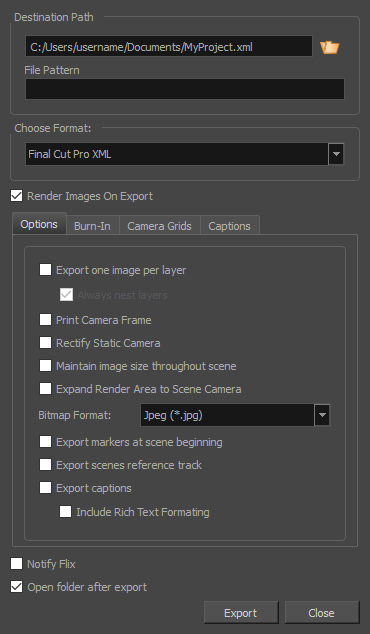
- In the Destination Path section, enter the folder and the name for the exported files and optionally, enter a file pattern for exported images.
- Select the target format, Final Cut Pro XML if you want to export a sequence for Final Cut Pro 7, or AAF if you want to export a sequence for Avid Media Composer.

- If you have already exported your sequence in the same destination folder in the past, and you just want to export the sequence again without exporting the images again, uncheck the Render Images on Export option. Otherwise, keep this option checked at all times.
- In the Options tab, enable the options you want to use for exporting your project:
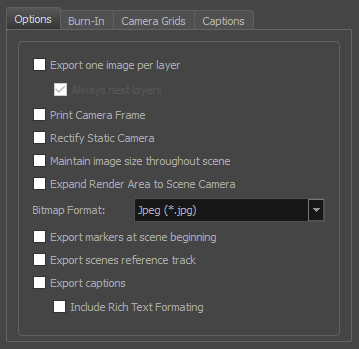
- Export one image per layer: Exports the drawing layers in your panels as separate video clips instead of flattening them together to make one clip per panel. This option is only available when exporting in Final Cut Pro XML format.
- Always nest layers: When exporting one image per layer, this will store all the layers for a single panel into a nested clip. By default, different layers are spread on different video tracks, except when a panel contains both camera movements and layer animations.
- Print Camera Frame: Prints the camera frames on the exported images. The first camera frame will be printed in green, and the last camera frame will be printed in red.
-
If the camera is at an angle in a panel, and there is no camera movement in that panel, enabling this option will render the panel as if the camera was at a straight angle.
- Maintain image size throughout scene: By default, the resolution of each image that is exported so that, at the end of a camera zoom-in, or at the beginning of a camera zoom-out, there is no pixelation. This means that the smallest camera frame in each panel must be at least the same resolution of the project. Hence, panels with small camera frames will have to be exported at a bigger resolution than other panels. For example, the following panel must be exported in a bigger resolution than the project's resolution, so that the smallest camera frame has the same resolution as the project:
- Expand Render Area to Scene Camera: By default, exported panels only cover the area covered by the camera movements in the panel. With this option enabled, exported panels will cover the area covered by the camera movements in all the panels in their scene combined. That way, if all the exported panels in a scene are combined, the elements of the scene will all be in their proper position respective to each other.
- Bitmap Format: Allows you to select the image format in which to save the exported panels:
- Jpeg (*.jpg): A very compact image format with lossy compression.
- Targa (*.tga): An image format with basic lossless compression.
- Photoshop (*.psd): The format used to store Adobe Photoshop projects. This format is uncompressed.
- Portable Network Graphics (*.png): An image format with strong lossless compression.
- Export Markers at Scene Beginning: Places a chapter marker at the beginning of each scene. These markers are used to find the in-point of each scene when conforming from Final Cut Pro to Storyboard Pro. The markers are named "Scene:" followed by the name of their respective scene, and they have a unique scene ID and chapter marker as their comment.
- Export scenes references track: Adds an extra video track to the sequence in which images indicating the number of the current scene are displayed.
- Export Captions: Includes the captions of each panel as metadata in the exported sequence. The captions can be edited in the sequence, and importing modified captions will update the captions in the Storyboard Pro project.
- Include Rich Text Formatting: If you're exporting the project's captions and your captions have special text formatting, this will export the captions in HTML instead of plain text, to preserve their formatting. If you export your captions in plain text, then re-import them, they will lose their formatting. However, plain text captions are easier to read and edit in third party software.
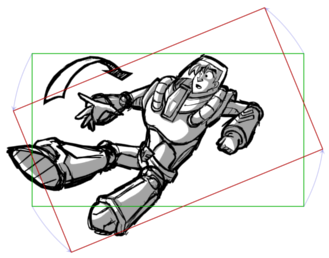

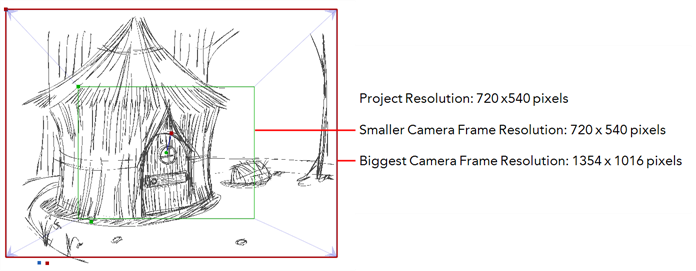
This can also mean that, within a same scene, a panel that has a camera zoom-in or zoom-out will have to be exported in a bigger resolution than the other panels in the scene. With this option enabled, all the panels in any given scene are exported in the same resolution.
In the following example, the camera goes from 1 to 2 in the first panel, then from 2 to 3 in the second panel, but both panels are exported to cover the whole camera movement, from 1 to 2 to 3:
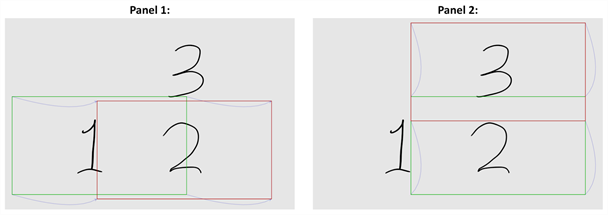
- In the Burn-In tab, if you want to print the scene names and panel numbers onto the rendered images, check the Print Scene and Panel Numbers check-box.

- In the Camera Grids tab, using these options, decides whether you want any kind of camera frame to be printed into the exported files:
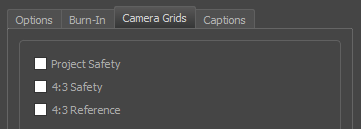
- Project Safety: Prints the safe area on your video
. - 4:3 Safety: Prints the 4:3 safe area on each panel of your storyboard that has a camera movement.
- 4:3 Reference: Prints the 4:3 area on each panel of your storyboard that has a camera movement.
- In the Captions tab, you can choose to print any of your storyboard’s captions into the exported movies using the following options—see About Captions.
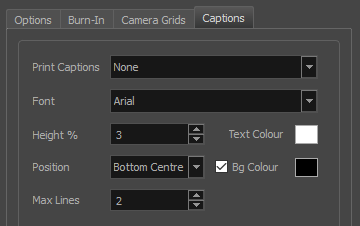
- Print Captions: Choose whether to not print captions (None) or select one of your project’s captions to print into the exported movies. By default, a Storyboard Pro project has Action Notes, Dialog, Slugging and Notes captions, but you can also choose to print custom captions if your project has any.
- Font: Select which font the captions will be printed in. By default, they will be printed in Arial.
- Height %: Sets the size of caption lines relative to the height of the exported movies. For example, if exporting a movie at 1080p with 3% Height captions, each caption line will be 32 pixels in height.
- Position: Prints the captions at either the Top Left, Top Centre, Top Right, Bottom Left, Bottom Centre or Bottom Right of the movie. By default, captions are printed to the Bottom Centre.
- Max Lines: Sets the maximum amount of caption lines to print on each panel. If a caption being printed requires more than the maximum amount of lines, it will be cut off with an ellipsis (...) at the end. Note that even if captions are printed at the bottom, they will be aligned to the top of the space reserved for them, which is calculated by the amount of Max Lines x the Height %. Therefore, if this setting is too high and captions are printed at the bottom, they may appear closer to the middle of the picture than to the bottom.
- Text Colour: Select the font colour in which to print the captions.
- Bg Colour: Select the background colour on which to print the captions. If the checkbox is unchecked, the captions will be printed directly into the rendered picture. Otherwise, they will be printed in rectangular boxes of the chosen colour.
- Select the Notify Flix option to automatically update the Flix assets database.
- Select the Open folder after export option to open the folder where the files will be stored when the export is complete.
- Click on Export.
Time Estimated 15 mins
Difficulty Level Intermediate